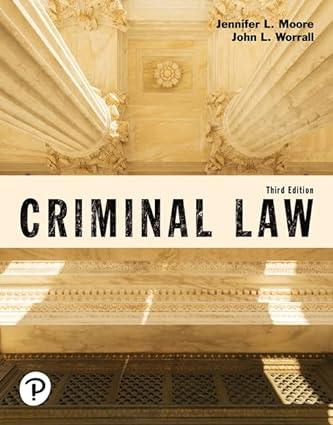Defendants moved to dismiss accusatory instruments charging them with criminal mischief in the fourth degree, making graffiti,
Question:
Defendants moved to dismiss accusatory instruments charging them with criminal mischief in the fourth degree, making graffiti, and possession of graffiti instruments. The Criminal Court, City of New York, New York County denied the motion.
The defendants are charged with Criminal Mischief in the Fourth Degree, Making Graffiti, and Possession of Graffiti Instruments. The accusatory instrument states in pertinent part that defendant Torres was observed “removing posters from scaffolding at” Broadway and 49th Street in New York County and the defendant Neal was seen “standing approximately three feet from” Torres, “applying glue to said scaffolding and placing posters on said scaffolding.” Neal was “holding a bucket containing glue as well as a brush commonly used for applying glue” and “that said glue caused damage to the scaffolding.” The factual allegations also state that Leonard Base of AJ Contracting “is a custodian of said scaffolding and that defendants did not have the permission to damage the property”.
Defendants now move to dismiss the charges on the ground that the accusatory instrument is facially insufficient in that the factual allegations do not support the crimes charged.
Meaning of “Graffiti” under Penal Law §§ 145.60 and 145.65.
Defendants argue that the acts charged—the use of glue to affix posters on scaffolding—do not constitute the making of “graffiti” under Penal Law § 145.60. They also argue that the glue and posters cannot constitute “graffiti instruments” under Penal Law § 145.65.
The defendants rightly point out that the usual meaning of the term “graffiti” is limited to some kind of writing. The term derives from a Greek word meaning “to write” and, as defendants point out, numerous cases use the term “graffiti”
with this exclusive meaning. Indeed, some cases implicitly distinguish between “graffiti” and the affixing of posters. The defendants also cite to numerous statutes of other states that use a definition of “graffiti” that is based exclusively on writing or instruments of writing. Unquestionably, the common meaning of the term “graffiti” would not include the conduct charged here.
The issue in this case, however, is not what is the common meaning of the term “graffiti.” Despite the title of the New York statutes, each contains a specific definition of “graffiti” and “graffiti instruments” that applies in this case and that must be construed by the court. Penal Law § 145.60(1) states: “the term ‘graffiti’ shall mean the etching, painting, covering, drawing upon or otherwise placing of a mark upon public or private property with intent to damage such property.”
Penal Law § 145.65 defines a graffiti instrument as a “tool, instrument, article, substance, solution or other compound designed or commonly used to etch, paint, cover, draw upon or otherwise place a mark upon a piece of property.” The People argue that what has occurred here is a “covering” of public or private property with the intent to damage it and that, as such, the affixing of posters with glue comes within the statute. Thus, regardless of the usual meaning of the term “graffiti,” the Court must decide whether the conduct alleged here comes within the definition enacted by the Legislature.
In construing statutes, the starting point is to examine the statutory text, the clearest indicator of legislative intent, and to determine whether it demonstrates a “plain meaning.”
If the words employed by the legislature have “a definite meaning, which involves no absurdity or contradiction, there is no room for construction and courts have no right to add to or take away from that meaning.”
The word “cover” is defined as “to overspread with something which marks or occupies the whole surface”;
“to spread on or over; put over the surface of.” It cannot be disputed that the words “covering” and “cover”
include the activities alleged by the defendants here. The defendants implicitly concede this point but argue instead that the Court should not examine the word “cover” in isolation but should instead consider it in the context of the other words in the statute.
. . The terms “etch, paint, draw upon” and “placing a mark” all denote different means of altering the appearance of a surface. The same alteration may be accomplished by the “covering” of a surface, for example through the use of paper affixed with glue. Thus, even a typical graffiti vandal might be said to “mark” a lamppost or doorway through the use of a paper sticker. The common meaning of the term “cover”
is ultimately consistent with the other terms in the statutory definition. There is no other, special meaning of “cover” that is somehow more consistent with these other terms. As a result, an examination of the other terms in the statute does not elucidate further the Legislature’s intention with respect to its use of the term “cover.” . . . In the end, “a court’s role is not to delve into the minds of legislators, but rather to effectuate the statute by carrying out the purpose of the statute as it is embodied in the words chosen by the Legislature.” Here, the language of the pertinent statute is “reasonably plain.” As a result, the court is not required to examine the legislative history behind the statute to further divine the meaning of the term “cover.”
. . . The motion to dismiss the accusatory instrument on the ground that the factual allegations are insufficient is denied.
Questions:-
1. Explain the defendant’s legal argument.
2. How does New York define the crime of graffiti?
Step by Step Answer:






